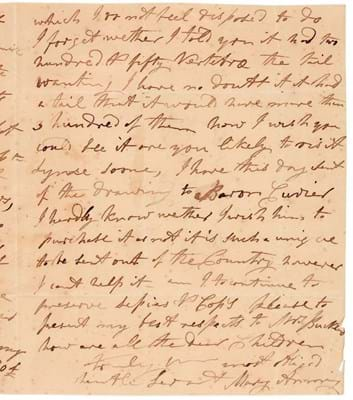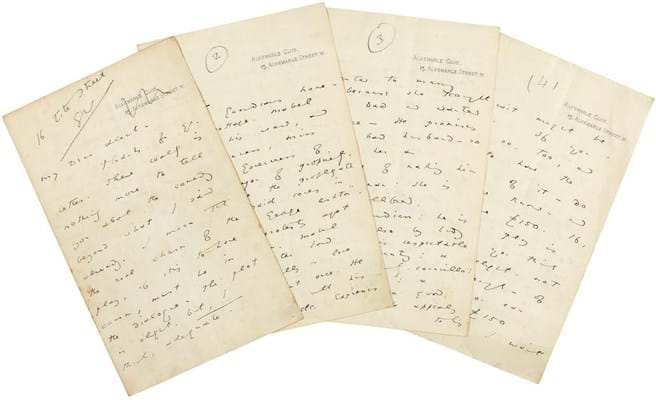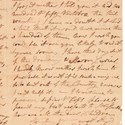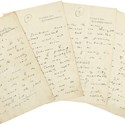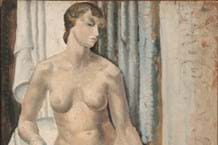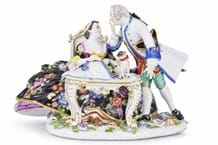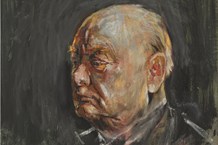A rare letter in the hand of the nowadays justly recognised and soon to become even more famous fossil hunter, Mary Anning, raised a far higher than predicted sum in the July 28-August 4 sale held by Sotheby’s (26/20/13.9% buyer’s premium).
It was the subject of a funding appeal organised by the Jurassic Coast Trust and Lyme Regis Museum. Though the estimate was initially set at £8000-12,000, a sum of £40,000 had been raised via donations from around the world in the hope of securing it.
However, in the end the only one of her letters ever seen at auction went to a private buyer for £80,000. The museum nevertheless expressed a hope that it might still find its way into a Lyme Regis display in the future.
Remarkable discoveries
Dorset girl Anning searched for and sold fossils found in the cliffs and on the beaches near her Lyme Regis home, and made some remarkable discoveries. She is today the subject of several biographies and in a soon to be released film, Ammonite, she is played by Kate Winslet.
She did become something of a local celebrity in her day but her gender and class prohibited her from ever becoming a member of the scientific establishment.
It is only in recent decades that Anning’s true importance has been fully acknowledged.
Her father, a cabinetmaker, sometimes boosted his earnings by selling fossils to visitors and in 1811, when Anning was just 12, she and her brother made their first big find, the skull of an ichthyosaur.
Addressed in February 1829 to the Rev William Buckland, a theologian, geologist and palaeontologist at Oxford, the letter seen at Sotheby’s includes a note of coprolites, identified by Anning as fossilised faeces (the subject of an article at the time by Buckland), but the key part of the letter relates to the “new skeleton” she and her brother had found. This was the Plesiosaurus dolichodeirus now in London’s Natural History Museum.
Anning wrote “…I forget wether [sic] I told you it had two hundred & fifty Vertebrae the tail wanting & I have no doubt if it had a tail that it would have more then 3 hundred of them…”. She also explains that as Bristol has offered only £30 she will send her drawing of it to Baron Cuvier, despite her misgivings about it going overseas.
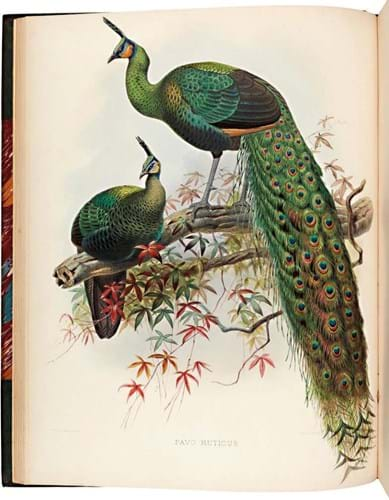
Natural history lots in the Sotheby’s sale included a two volume first of DG Eliot’s Monograph of the Phasianidae, or Family of Pheasants of 1870-72 with its 79 hand-coloured litho plates by Joseph Smit and JG Keulemans after Joseph Wolf. It sold for £55,000.
Earnest beginnings
Sold at a low-estimate £100,000 among a number of Oscar Wilde lots on offer was a letter of 1894, addressed to the actor and impresario George Alexander, in which he provides a 16pp, act by act summary of the play that was eventually to become The Importance of being Earnest.
Certain elements of the play are missing at this early stage. There is no handbag, for example, and Alfred/ Algie does not have his own fictional friend, Bunbury. Neither had Wilde yet decided exactly how the final act was to resolve itself.
The letter was last seen at auction in 1999, when Sotheby’s New York sold it for $70,000 (then around £44,000).
Sold at £38,000 was one of 100 large paper copies of the 1899 first edition of the play printed by Leonard Smithers – one inscribed by Wilde for his friend and trusted supporter, Reginald Turner.
In a letter he sent to Turner around this time, Wilde wrote “I am sending you, of course, a copy of my book… I hope you will find a place for me amongst your nicest books, not near anything by Hichens or George Moore. I should like it to be within speaking distance of Dorian Gray…”
In 2004, at Christie’s New York, this copy had sold at $26,000 (then around £14,000).
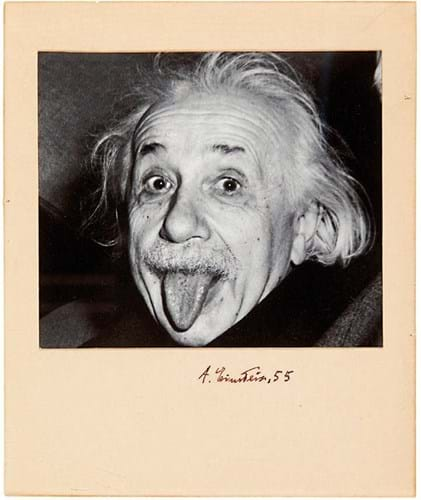
Offered for sale to benefit the Give Peace a Chance foundation, this photo-portrait may bear Einstein’s final autograph. A well-known photograph taken by Arthur Sasse on the occasion of his 72nd birthday celebrations at the Princeton Club, this print was signed just two days before he died in April 1955. Suffering from a ruptured abdominal aortic aneurysm, Einstein was admitted to hospital but refused surgery: “I want to go when I want. It is tasteless to prolong life artificially; I have done my share, it is time to go. I will do it elegantly.” The photo sold for £32,000 at Sotheby’s.
Sold at £300,000 in this Summer Miscellany sale, and as noted in News, ATG No 2454, was Truman Capote’s final typescript for Breakfast at Tiffany’s.
In it he made a last-minute change to the name of the lead character, Connie Gustafon becoming Holly Golightly, as immortalised in the later film version starring Audrey Hepburn.


